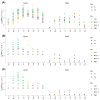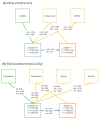Vibrio vulnificus and Vibrio parahaemolyticus in Oysters under Low Tidal Range Conditions: Is Seawater Analysis Useful for Risk Assessment?
- PMID: 36553807
- PMCID: PMC9778087
- DOI: 10.3390/foods11244065
Vibrio vulnificus and Vibrio parahaemolyticus in Oysters under Low Tidal Range Conditions: Is Seawater Analysis Useful for Risk Assessment?
Abstract
Human-pathogenic Vibrio bacteria are acquired by oysters through filtering seawater, however, the relationships between levels of these bacteria in measured in oysters and overlying waters are inconsistent across regions. The reasons for these discrepancies are unclear hindering our ability to assess if -or when- seawater samples can be used as a proxy for oysters to assess risk. We investigated whether concentrations of total and human pathogenic Vibrio vulnificus (vvhA and pilF genes) and Vibrio parahaemolyticus (tlh, tdh and trh genes) measured in seawater reflect concentrations of these bacteria in oysters (Crassostrea virginica) cultured within the US lower Chesapeake Bay region. We measured Vibrio spp. concentrations using an MPN-qPCR approach and analyzed the data using structural equation modeling (SEM). We found seawater concentrations of these bacteria to predictably respond to temperature and salinity over chlorophyll a, pheophytin or turbidity. We also inferred from the SEM results that Vibrio concentrations in seawater strongly predict their respective concentrations in oysters. We hypothesize that such seawater-oyster coupling can be observed in regions of low tidal range. Due to the ease of sampling and processing of seawater samples compared to oyster samples, we suggest that under low tidal range conditions, seawater samples can foster increased spatial and temporal coverage and complement data associated with oyster samples.
Keywords: Crassostrea virginica; Vibrio parahaemolyticus; Vibrio vulnificus; aquaculture; ecology; model; seafood safety; tidal range.
Conflict of interest statement
The authors declare no conflict of interest.
Figures






References
-
- Center for Disease Control and Prevention Vibrio Species Causing Vibriosis. Division of Foodborne, Waterborne, and Environmental Diseases. [(accessed on 1 January 2022)]; Available online: https://www.cdc.gov/vibrio/index.html.
-
- Oliver J.D. The Biology of Vibrio vulnificus. Microbiol. Spectr. 2015;3:3. doi: 10.1128/microbiolspec.VE-0001-2014. - DOI - PubMed
Grants and funding
LinkOut - more resources
Full Text Sources
Miscellaneous

